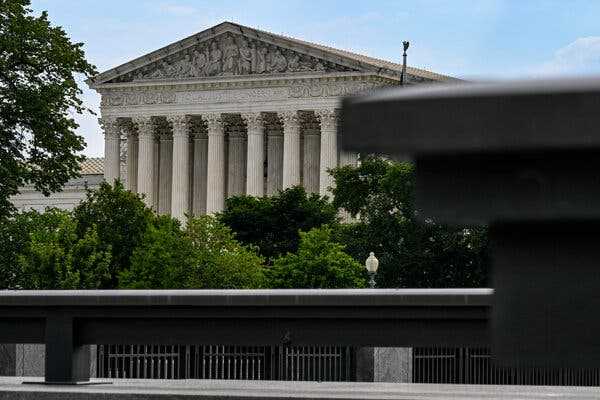The case concerned Billy Counterman, a Colorado man who became obsessed with a singer-songwriter, sending her disturbing messages on Facebook.
- Give this articleShare full article

Justice Elena Kagan wrote in a majority opinion that the risk of chilling protected speech warranted imposing an added burden on prosecutors.
The Supreme Court ruled on Tuesday that the First Amendment imposes limits on laws that make it a crime to issue threats on the internet, requiring prosecutors to prove that defendants had acted recklessly in causing emotional harm.
Writing for five justices in the 7-to-2 decision, Justice Elena Kagan took a middle path.
“The state must show that the defendant consciously disregarded a substantial risk that his communications would be viewed as threatening violence,” she wrote. “The state need not prove any more demanding form of subjective intent to threaten another.”
Justice Kagan acknowledged that “true threats,” like libel, incitement, obscenity and fighting words, are not protected by the First Amendment. But she said the risk of chilling protected speech warranted imposing an added burden on prosecutors.
“The speaker’s fear of mistaking whether a statement is a threat; his fear of the legal system getting that judgment wrong; his fear, in any event, of incurring legal costs — all those may lead him to swallow words that are in fact not true threats,” she wrote.
The case arose from the fixation of a Colorado man, Billy Counterman, with a singer-songwriter identified in court papers as C.W. He sent her many messages on Facebook, opening new accounts when she blocked him.
“You’re not being good for human relations,” one message said. “Die. Don’t need you.”
Another asked, “Was that you in the white Jeep?”
Justice Kagan wrote that “the messages put C.W. in fear and upended her daily existence,” adding, “She stopped walking alone, declined social engagements and canceled some of her performances, though doing so caused her financial strain.”
Mr. Counterman was prosecuted under a Colorado law that made it a crime to send repeated communications that would cause a reasonable person to suffer serious emotional distress and did cause such harm. He was convicted and sentenced to four and a half years in prison.
Lawyers for Mr. Counterman argued that the law violated the First Amendment because it did not require proof that he intended to cause the distress.
“The notion that one could commit a ‘speech crime’ by accident is chilling,” they wrote in a Supreme Court brief. “Imprisoning a person for negligently misjudging how others would construe the speaker’s words would erode the breathing space that safeguards the free exchange of ideas.”
Lawyers for the state responded that it was enough to look at the words in question, how they were conveyed and the response they elicited. The speaker’s subjective intent, they said, does not matter.
Justice Kagan analyzed the question by examining how the Supreme Court had treated other categories of unprotected speech, notably libel. Noting that public figures must show at least reckless disregard of the truth — meaning subjective awareness of probable falsity — to prevail in libel cases, she said something similar was required in true-threats prosecutions.
In the context of threats, she wrote, quoting an earlier opinion, recklessness “means that a speaker is aware ‘that others could regard his statements as’ threatening violence and ‘delivers them anyway.’”
Chief Justice John G. Roberts Jr. and Justices Samuel A. Alito Jr., Brett M. Kavanaugh and Ketanji Brown Jackson joined Justice Kagan’s majority opinion.
Justice Sonia Sotomayor, joined for the most part by Justice Neil M. Gorsuch, agreed with Justice Kagan’s bottom line but for different reasons. She said she would analyze the case as involving stalking rather than threats.
Justice Clarence Thomas issued a brief dissent that repeated his call to reconsider New York Times v. Sullivan, the landmark 1964 libel decision interpreting the First Amendment to make it hard for public officials to prevail in libel suits.
“It is thus unfortunate,” he wrote, “that the majority chooses not only to prominently and uncritically invoke New York Times, but also to extend its flawed, policy-driven First Amendment analysis to true threats, a separate area of this court’s jurisprudence.”
In a second dissent, Justice Amy Coney Barrett, joined by Justice Thomas, wrote that an objective standard was sufficient in true-threats prosecutions.
“The bottom line is this,” she wrote, quoting phrases from Justice Kagan’s opinion. “Counterman communicated true threats, which, ‘everyone agrees, lie outside the bounds of the First Amendment’s protection.’ He knew what the words meant. Those threats caused the victim to fear for her life, and they ‘upended her daily existence.’ Nonetheless, the court concludes that Counterman can prevail on a First Amendment defense. Nothing in the Constitution compels that result.”
The Supreme Court considered a similar case in 2014, involving a Pennsylvania man who was prosecuted for making threats on Facebook in the form of rap lyrics after his wife left him.
Chief Justice John G. Roberts Jr., writing for the majority when the case was decided in 2015, said prosecutors must do more than prove that reasonable people would view statements as threats. The defendant’s state of mind matters, the chief justice wrote, though he declined to say just where the legal line is drawn.
Justice Barrett suggested that Justice Kagan’s position in the new case, Counterman v. Colorado, No. 22-138, was unprincipled.
“The reality,” she wrote, “is that recklessness is not grounded in law, but in a Goldilocks judgment: Recklessness is not too much, not too little, but instead ‘just right.’”
Responding in a footnote, Justice Kagan said she was not offended. “In law, as in life," she wrote, “there are worse things than being “just right.’”
Adam Liptak covers the Supreme Court and writes Sidebar, a column on legal developments. A graduate of Yale Law School, he practiced law for 14 years before joining The Times in 2002. @adamliptak • Facebook
- Give this articleShare full article
Source: nytimes.com



